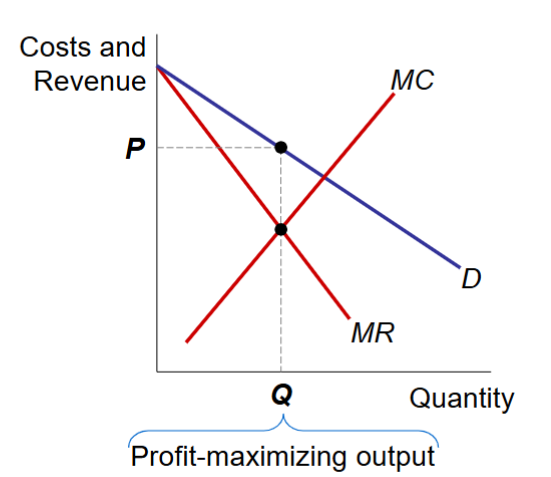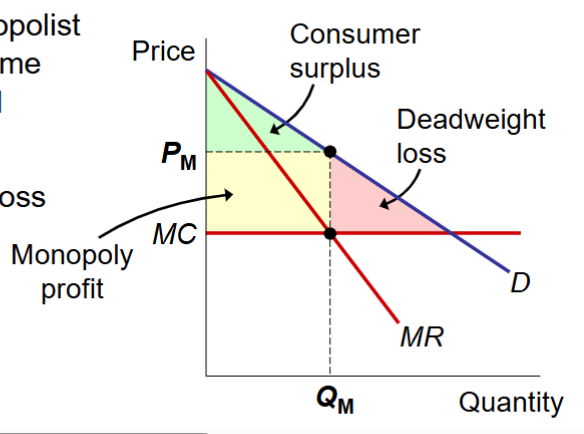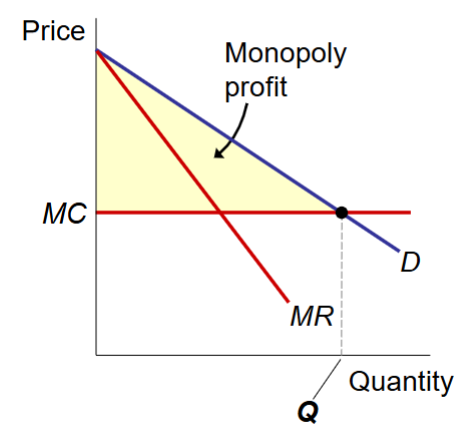Lecture 10: Monopoly
1/43
There's no tags or description
Looks like no tags are added yet.
Name | Mastery | Learn | Test | Matching | Spaced |
|---|
No study sessions yet.
44 Terms
What is a monopoly?
A monopoly is a firm that is the only seller of a product without close substitutes
What is the difference between monopoly and perfect competition?
Monopoly and perfect competition are different, since a monopoly has market power and can influence the market price
Market Power
The ability to influence the market price of the product it sells
Monopolies have this ability and not competitive firms
What is the main cause of monopolies?
The main cause of monopolies is barriers to entry, which prevents other firms from entering the market.
What are three sources of barriers to entry?
A single firm owns a key resource.
The government gives a single firm the exclusive right to produce the good.
Natural monopoly (one firm can make the entire market Q at a lower ATC than could several firms)
How does ATC look like for a natural monopoly?
ATC slopes downwards due to a huge fixed cost and a small MC
Fixed cost is large, change in total cost, as quantity increases by 1 is small
So ATC is lower if only one firm supplies
How does the market demand curve look like in a competitive market?
In a competitive market, the demand curve slopes downward
How does the demand curve for a competitive firm look like?
The demand curve for any individual firm’s product is horizontal at the market price
Firm can increase Q without effect on P
MR= P
What demand curve does a monopolist face?
A monopolist is the only seller, so it faces the market demand curve
To sell more Quantity (Q), the firm, must reduce Price (P)
So MR doesn’t equal P
What is the relationship between the demand curve (price) and MR (marginal revenue) for a monopoly?
The MR curve is always below the Demand curve (price)
To sell more, the monopolist must lower the price on all units, so the extra revenue from the last unit is less than its price.
How does increasing Q (quantity) affect revenue?
Increasing Q has two effects on revenue
Output effect (Higher output raises revenue)
Price effect (Lower price reduces revenue)
Output effect
Effect when Q increases and the higher output increases revenue
Price Effect
Effect when Q increases and the lower price reduces revenue
What must a monopolist do to sell a larger Q?
To see a larger Q, a monopolist must decrease the price on all of the units it sells
MR<P
MR could even be negative if the price effect is greater than the output effect
How does a monopolist maximize profit?
A monopolist maximizes profit by producing at the quantity where MR= MC
Monopolist sets the highest price consumers are willing to pay from the D curve
How to find the profit maximizing quantity?
The profit maximizing quantity is there MR= MC
Find P from the demand curve at this Q

What is a monopolist’s profit equal to?
Similar to a competitive firm
The monopolist’s profit is equal to
(P- ATC) x Q

What does a competitive firm have in terms of supply?
A competitive firm:
Takes Price (P) as given
Has a supply curve is the portion of its MC curve above the AVC curve, showing how Q increases as P rises as long as P ≥ AVC.
Why does a monopoly not have a supply curve?
A monopoly doesn’t have a supply curve
It’s a price maker
Q doesn’t depend on P, but Q and P are determined by MC, MR, and the demand curve (It’s quantity depends on both price and demand, not just price)
What happens in a perfect competitive equilibrium?
In a perfect competitive equilibrium, P= MC and total surplus is maximized
What happens in the monopoly equilibrium?
In the monopoly equilibrium,
P > MR = MC
Value to the buyers of an additional unit (P) exceeds the cost of the resources needed to produce that unit (MC)
Monopolist produces less than the socially efficient quantity, because it restricts output to raise price.
Monopoly Q is too low, could increase total surplus with a larger Q
Monopoly results in deadweight loss
In a competitive equilibrium, what is P equal to?
P= MC and total surplus is maximized
In a monopoly equilibrium, what is P equal to?
P > MC, causing deadweight loss
The firm faces a downward-sloping demand curve, so selling more requires lowering price on all units, making marginal revenue less than price while profit is maximized where MR = MC.
Price Discrimination
Selling the same good at different prices to different buyers
What is the characteristic used in price discrimination?
WTP is used in price discrimination
A firm can increase profit by charging a higher price to buyers with higher WTP
Single Price Monopoly
Where the monopolist charges the same price (PM) to all buyers
Causes a deadweight loss

Perfect Price Discrimination
Monopolist produces the competitive quantity, but charges each buyer his or her WTP
Monopolist captures all CS as PS, no deadweight loss, or consumer surplus

Why is perfect price discrimination not possible in the real world?
In the real world, perfect price discrimination isn’t possible, since:
No firm knows every buyer’s WTP
Buyers don’t announce their WTP to sellers
What do firms do to price discriminate to their best ability?
Firms divide customers into groups based on some observable trait, like age, that is likely related to WTP
Do this to try to price discriminate
Example of price discrimination (movie tickets)
For movie tickets, there are student discounts, since students are more likely to have a lower WTP than people who pay full price
Example of price discrimination (need based financial aid)
Low income families have a lower WTP for their children’s college education
Schools price discriminate by offering need- based aid to low income families
In the real world, why do many firms have market power, even though a pure monopoly is rare?
Many firms have market power since they sell a unique variety of a product, have a large market share and few competitors
Why isn’t a monopoly’s profits unlimited?
A monopoly’s profits aren’t unlimited, since a high price decreases the quantity
Even though a monopoly can control the price of the good it sells, a high price decreases quantity
What is the benefit of allowing monopoly producers to charge higher prices and earn higher profits?
The benefit of allowing for monopolies, is an increase in desirable behaviors, like the creation of new drugs during research
Natural Monopoly (Full definition)
A type of monopoly, where 1 firm can supply a good or a service to an entire market at a lower cost than two or more firms
A single firm can produce any amount of output at the lowest cost
What happens to a firm’s ATC if it’s a natural monopoly?
For a natural monopoly, the firm’s ATC curve continually declines
When production is divided between more firms, each firm produces less and ATC increases
When does a natural monopoly become a competitive market?
A natural monopoly becomes a competitive market when a market increases
What can a monopoly do that a competitive firm can’t?
A competitive firm is small and has no power to influence the price of its output, while a monopoly can change the price of its good by adjusting the quantity to the market
How does the demand curve look like for competitive firms?
The demand curve= horizontal line at the market price, meaning it is perfectly elastic. This is because the firm is a price taker; it can sell any quantity it produces at the market price
How does the demand curve look like for a monopoly?
The demand curve for a monopoly is the market demand curve
Downward sloping’
As price increases, consumers buy less
As a result, the monopoly has to accept a lower price if it wants to sell more output
How does a monopoly’s revenue look like?
As quantity increases, the price decreases for a monopoly, since it’s demand curve is the market’s demand curve
A monopolist’s marginal revenue is less than the price of its good
Due to downward sloping demand curve
To increase the amount sold, a monopoly has to lower the price it charges to all customers
What is the demand curve also for a monopoly?
The demand curve for a monopoly is also the price curve, and also the average revenue curve
What happens when a monopoly produces a low level of output (Q)?
When a monopoly produces a low level of output